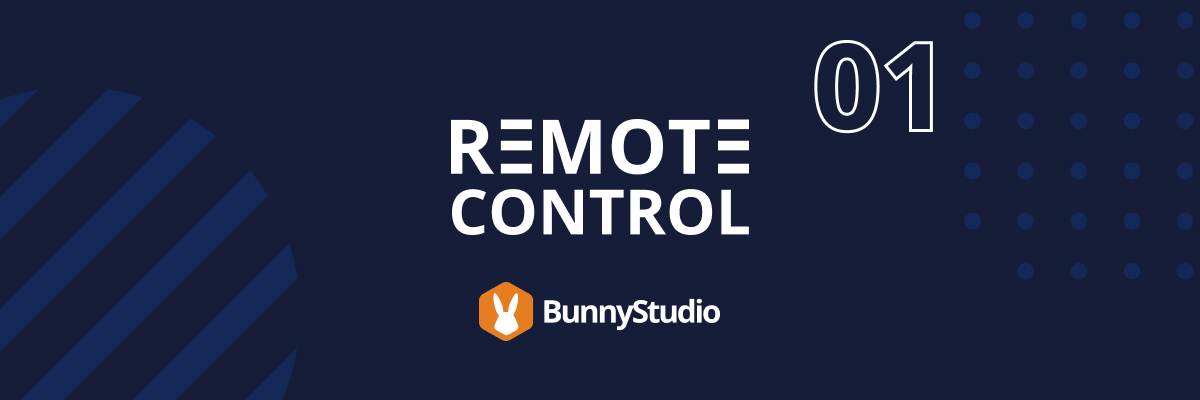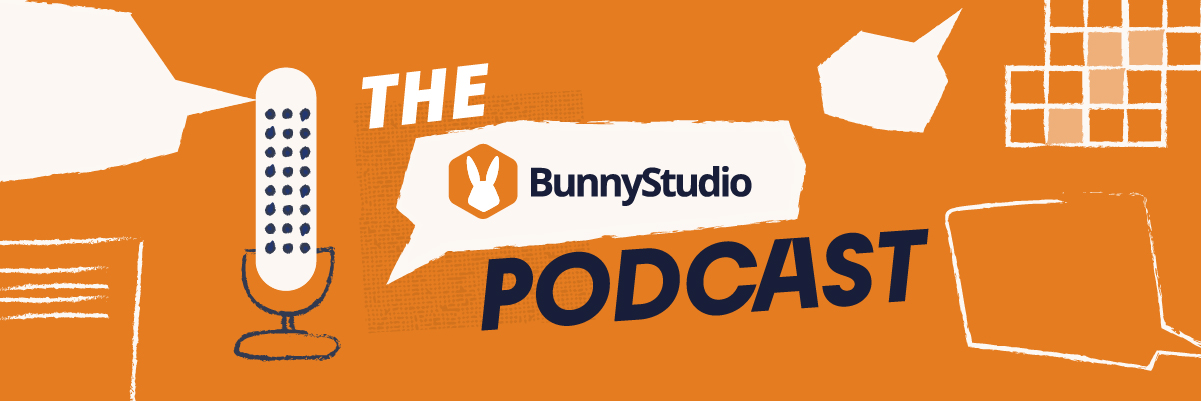— PROLOGUE —
The number of remote workers is constantly growing. Among them are parents – drawn to the possibility of a better work/life balance for their families.
So, what makes remote work so valuable to parents? And what do their experiences with these unique challenges tell us about global social issues?
We talk to Leigh – She’s a parent with a ton of remote work experience. Together, we’ll discover the story of an invaluable lesson she learned about parenting – and people.
A lesson that will change how you think about remote work.
— INTRO —
Hey, I’m Maika Hoekman, Head of People Operations at Bunny Studio, and I’m a remote worker.
Welcome to Remote Control: A series that helps you unlock the possibilities of remote work. Together, we’ll find success stories, expert tips, and insights to help you navigate the new office.
Remote Control is brought to you by Bunny Studio. Trusted by more than 50,000 companies every year, Bunny Studio helps businesses scale their creative needs with a vetted crowd of freelancers.
— ACT ONE —
Maika:
Raising a kid isn’t easy. Whether you’re giving care to your family at home or providing for them at work, there’s a lot of responsibility – no matter what your role is.
For so long, the only option for working parents was to be at your workplace. You build your schedule around your children and your job. And it’s a juggling act, making sure there’s always someone there to look after your children – even when you have to work. It’s a rigid world – one that builds a wall between your family and your job. But that’s not the world we live in anymore.
Remote work grew by 400% between 2010 and 2019. That’s 5 times the amount of remote workers in less than ten years.
In 2020, people adopted remote work at a scale we’d never seen before. For a lot of us? It was our first time. Now we’ve had a taste of what remote work can offer our companies – and ourselves.
Bunny Studio, my company, has worked remotely for 8 years. We’ve navigated this exciting new environment and are still learning so much about the future of our work.
And that future includes working parents. So, what does remote work mean for them? Parenting is a drastically different experience when you can provide for your family without needing to leave your home.
It gives you the freedom to break down that rigid wall – the one separating you as a parent from you as a worker.
But new possibilities bring new difficulties. And as much as we cherish more time with our loved ones, there are interesting challenges to bringing the office home with you. Challenges many of us have been facing for the first time.
Leigh:
I live in a very untraditional family, I guess, in the Philippines. I’m a single mom. That’s not very usual here. And I live with my sister who’s unmarried, and my mom. So I actually have a very good support system. To the point where my son thinks he has three parents, he introduces us to all this “these are my parents.”
Maika:
That’s Leigh. She’s a few things: Product Manager, Entrepreneur, blogger. She’s also a mother. A working mother.
Like a lot of us, Leigh relies on her family’s support. You can’t be everywhere at once. Partners, parents, immediate family – you get help where you can.
Leigh:
We live in a very tiny apartment, my mom is 82, and she’s very strong and clear thinking for 82, but she is 82, and she likes her naps now. So it’s really become more me. And my sister is an essential worker. I mean, she is a doctor.
Maika:
Leigh has worked remotely part-time since 2016. She’s found benefits that were just not possible when she had to be in the office. And the other working parents are realizing these advantages.
Kasia:
Overall remote work is not a new concept to me as it is for many people in 2020. So was long before 2020 I’ve been observing the need for flexible and remote work. And, not necessarily as a need of the millennial generation to travel the world and be location-dependent, but really the need of working parents to be able to manage their lives better and fulfill their care responsibilities.
Maika:
That’s Kasia. She’s a gender and marketing consultant for UNICEF and the World Bank. She’s seen parents across the world adapt to this new home office.
Kasia:
With a more flexible schedule, parents can pick up their children at certain times and make up for the time lost and at a time, and it’s the possibility of making your schedule work for both your work and your family and your life outside of your family as well. So, that additional flexibility that remote work gives you, yeah, that, that’s what I would say is the biggest added value.
Maika:
Parents realized remote work brought the flexibility to be where their families needed them when they needed them. It’s no surprise that companies with remote work found they had incredible hiring advantages.
But 2020 thrust remote work onto us. It threw us into the deep end in a way that challenged even the well-prepared.
Gil:
What people have been going through is not remote work. What we’ve been doing for the last six months is actually been working from home during a pandemic. And I’ll tell you, as a person who’s been working remotely for two decades, it is not at all the same thing. It’s been different for me. I’ve been doing it for almost 20 years, and now suddenly I don’t have the same experience.
Maika:
Gil Cohen knows more than most about how workers experience remote work. He’s a father and founder of his Employee Experience consultancy. He knows that 2020 isn’t what to expect from the future of remote work. But it’s been an immediate reality for a lot of us.
Gil:
The boundaries between work and life are blurred. You’re sitting working in the same space in which you’re then relaxing at the end of the day; because of COVID, most of us don’t have somewhere else to go to relax. We don’t have something else to do, and neither do our kids. So they need to be occupied longer. So it takess fewer hours to really get what needs to be done, done.
Leigh:
I know that for other parents whose children can, self-managed, it’s perfectly possible to multitask when you have a child with special needs. It’s almost impossible to multitask. So you’re there, you have to be there. My son has autism. He’s on the autism spectrum. It’s mild. He’s’s verbal, he’s also 15 years old. So now that my son is 100% at home with no contact with other kids, we get to be much more present in his life. And I necessarily have to prioritize him versus, let’s say, a meeting.
Maika:
Working from home during a pandemic hasn’t been easy. But the responsibilities of children add even more weight. And parents are realizing that working from home requires strategies and support that we haven’t yet considered.
With workers happier at home, and no need to pay for expensive office space, there are many benefits. But getting those benefits means companies need to adjust their employee approach.
Kasia:
What remote workers often struggle with and especially, parents is managing their work time and their downtime, and having that work-life balance separating what is home and what is work. Is that an additional challenge, for remote working parents, and I would say also not getting enough support and understanding from organizations and employers would be, would be another one.
Maika:
No matter the approach, the goal is the same. Helping our people do the best work they can. And by helping working parents get the best outcomes for their families, we get supported, grateful team members.
Leigh:
I’m noticing now, very particularly now, that person who I think I am is actually quite small in proportion to the person that other people need me to be. So right now people need me to be a mom. My son needs me to be a mom. My sister needs me to be a mom so that she can go and do the work that she has to do. And my mom needs me to be a better mother, so she can stop worrying, so it’s also been hard.
Maika:
So… how does Leigh stay on top of her many roles as a parent working remotely? Find out after the break.
Break:
Hey! If you’re liking what you hear and you have a minute, please subscribe, rate, and review on whatever app you’re using to listen. We are on Spotify, Google Podcasts, Amazon, and more! This helps us get the word out to others in this industry. Thanks for listening.
— ACT TWO —
Gil:
Somebody who wants to, you know, have people call in every half hour to put on this tracking software. Well, they think their role as a manager is to control and to manage people, and that’s not the only role of the manager. It’s also to set the environment and by understanding how you can create an environment where people can thrive without being controlled. Because you have to understand that it’s possible to be able to accomplish that. So, give up on the need for control and create the experience that people will want to be productive. People can work remotely and be more productive than they’ve ever been.
So by understanding that. By not believing, a lot of times lack of trust comes from the belief that, if you don’t watch somebody, they’re not going to do their work, which makes me question what kind of employee they were before they became a manager, but that’s a different story.
Maika:
We’ve already found that parents highly value remote work. For themselves, for their families. And they value flexibility. And as Gil pointed out, not all organizations can create the best environment for their remote employees.
So what is the best environment? What strategies can companies – and working parents – use to get the most out of their work?
Let’s return to Leigh, and how she started exploring a working environment not much older than her son.
Leigh:
Since 2016, I’ve instituted something called Work Anywhere Wednesday. Metro Manila has the worst traffic on the planet and it was eating up people’s lives. By the time they got home, they were not capable of spending any kind of quality time.
So we said, okay, maybe people can actually be more productive if we allow them to just work anywhere once a week. And we deliberately put it in the middle of the workweek so that it didn’t feel like a long weekend. And, everybody, he had to sign a promise letter saying that they promised that the work would be better, not the same, but better.
Since that time, people here in the office at least we’re used to being more of a results-oriented culture rather than busy work or must spend more time in office to look capable culture, which is something also that we discouraged.
Maika:
A shift towards results-oriented work, away from just being “present”. That’s a pretty major cultural change. It’s a change that companies report going hand-in-hand with remote work.
It makes sense – with flexibility in space comes flexibility in time. And as long as the team hits their goals, the “Where” and “When” are just details.
This flexibility can swing the other way, and the lack of structure can cause chaos across a family’s tight schedule.
The question is, how do parents best coordinate with their teams and keep the structure that is necessary?
Kasia:
Parents working remotely are absolute multi-taskers. For example, my previous managers who were, parents as well, was really planning their week forward and communicating and speaking really loudly and proudly of how they’re managing the modern hoot and thought or hurt and their careers so they would plan their work and life commitments upfront and communicate them very clearly to the teams, which allowed the teams to understand their availability and their commitments, you know, in advanced. And, in that way, we always knew when they’re available and when they are not.
Leigh:
One huge thing that can support any kind of remote working parent is just “give me the time.” Maybe deadlines don’t need to be super tight. Don’t tell me a little later; tell me a little earlier, only devote so much energy and attention to any one thing at any given time. So if you don’t have any boundaries, you are actually just floating from one false urgency to the next without being able to sense what you’re actually trying to do.
Maika:
Overcommunication is central to remote work culture. For parents, it’s twice as important. Sharing expectations – and family responsibilities. Clear communication is how we give them support.
But what’s at the core of this support? There’s a lot of software tools that achieve similar results. Is there a universal one to simplify the process?
Gil:
Well, there isn’t necessarily a tool I can refer to you specifically or any technology or anything like that. Although there’s a lot of amazing technology out there right now.
Gallup has come out with numbers that up to 70% of the variability and employee engagement comes from a person’s direct manager. And so they are the key touchpoint through which a person really receives most of their employee experience. As a manager, you’re managing a whole perso; you’re not just managing a resource. You’re not just managing an entity to get a job done, but a whole person.
Maika:
Team members’ engagement brings concrete benefits for organizations, and Gil knows just how much it can bring to the table.
Managers need to make sure they make the best environment for their team. And this can mean adjusting their approach to a remote environment.
Now, these strategies need to be implemented across the organization. And that means, team members also need to adjust their approach.
So what responsibilities do workers have to our teams?
Leigh:
It’s important for working parents to have clear boundaries as to what they can deliver work. But I think it’s more important for you to be very clear about what you need to be doing for your family and why you need to be there.
Some parts of my life have boundaries still, but at the same time, others have become a little more forgiving. And I think when I tell people that’s my son. Okay. Now back to this meeting, then it’s fine. So. I think more and more, that sense of boundaries is inside. Not just external.
Maika:
In summary, remote workers need to develop deeper communication. And really make use of their time management skills – parents most of all. They benefit most from teams that understand their responsibilities and give them space to manage their busy lives.
Companies need to instill that flexibility into their culture. And that culture isn’t built – or sustained – by the people at the bottom.
Gil:
How can companies build an environment that’s built around having that flexibility? The reality is that needs to start at the top. Everybody’s ultimately going to be looking to their manager and looking to the CEO. Because the one thing that a lot of people forget is the CEO is also an employee of the organization.
And so the need model that they need to model that flexibility. Because you can tell managers all you want that be flexible, but if their manager isn’t being flexible, it’s much less likely they’re going to be, so it needs to really start at the top of the organization.
— ACT THREE —
Maika:
2020 has been a year of drastic upheaval, paired with health concerns and financial uncertainty. Within this hardship comes insight – and understanding.
Gil:
One of my favorite expressions I’ve heard through this is we’re all in the same storm, but we’re not all in the same boat. That’s one thing that this remote work has really illuminated during COVID is that it’s very different person to person. One person could be completely home alone and worrying about isolation issues. One person could have three kids under the age of five and a spouse who has a full-time job. There are so many different possibilities.
Maika:
This collision of boundaries and responsibilities has affected all of us. But we’re about to find out how different it has been for specific groups.
Gil:
I work in the, uh, the basement here. My boys are upstairs, they’re six and eleven, they’re normal active kids, and they like to bounce around and jump around and be loud. And whereas previously I could rely on quiet from 9:00 AM until 3:00 PM every day, some days I have to spend more time on parenting because it’s not going to go away. And there are some times that I’m very, very grateful for my wife, that she does take care of them, that she’s there, that I’m able to, um, take care of my work.
Maika:
If you’re used to sharing parenting workloads, like Gil and his wife, then this adjustment won’t leave you out of your depth.
But for a lot of the world, there are well-documented inequalities. Inequalities in gender roles that lead to major systemic effects for women.
Kasia:
There is literally no country in the world where women and men are doing an equal share of care work and domestic work. Even before 2020, globally, women were doing three times as much on-the-page care and domestic work as men.
So with school closures and with increased demand for care for elderly and ill members of the family, there has been an increased demand to do that care work so, this is depending on already existing inequalities into gender division of care, work, and labor work.
Maika:
As a consultant for UNICEF, Kasia knows more than most how widespread this gender inequality is. And care work is often dismissed – unless you know how much it takes to do it.
Some remote workers can compensate for these domestic demands a lot more easily than others. Live-in carers can be prohibitively expensive in many western countries. In other countries, however, this level of assistance is commonplace.
Leigh:
For those of you who aren’t as familiar with, details of Filipino culture, it’s quite easier for people to hire someone to help with the children. And they’re called the Y Y a Y E. If your Yaya was with you when the pandemic started, then they were essentially in your household bubble. But if they were on a break. Or if they had to leave for where their hometown was, then I also know people who were caught without a lot of guys are spending time at home, and they’re seeing what only the majority of women have seen in many traditional families. They’re seeing how hard it is to work and be aware of where every child is at the same ti—peoplele who traditionally have worked outsourced full-time caring to their partner. I think now is a good time for them to review that approach.
Kasia:
With so many companies that are really shifting to flexible work arrangements, we can see that yeah, this model of working, which allows for, does balancing of work and care, is possible. So we can see fathers assuming more caregiving roles, which is also very important, and this can have good long-term impacts and the division of labor and division of care work as well.
Maika:
A shift to remote work has led to unforeseen steps toward gender equality. More men are realizing the demands of care work. Not only that, they’re sharing these roles in ways that they haven’t previously done.
With good reason – there’s much more at stake than a fair distribution of chores.
Kasia:
We are seeing the trends that social and economic toll of the COVID-19 crisis will be paid disproportionately by girls and women.
Look at the 2008 global financial crisis in the aftermath. Most of their support measures were provided to large infrastructure projects that mainly employed men while jobs were caught in teaching and nursing and public services, which are all female-intensive sectors. So, in the aftermath of 2020, we need to ensure that these female intensive sectors get equal attention and equal support and investment, as well.
Maika:
Remote work could help reduce gender disparity at home – and throughout societies. Add that to shared understanding between families and organizations. We’re looking at benefits way beyond individual households. We’re looking at the big picture – about as big as the picture gets.
But on the ground floor are working parents. They’ve got immediate concerns – as well as these promising futures.
For these parents, what does it mean to be committed to the remote work pathway? What do they have to keep in mind, day-to-day, to reach their family and career goals years from now?
Gil:
One of my favorite expressions that somebody said to me a while ago is that “time management is actually a myth.” Time’s going to pass by whether, whatever you do with it, it’s actually priority management. It’s that’s the reality is you have to manage your priorities. You have to prioritize what you’re doing with your time; then you’ll make the most use out of it. Oh, with the punches. Whatever happens, happens. And I think that’s one thing that’s been a silver lining since COVID is that people are a lot more accepting that there’s a human on the other end. And so if a little kid runs into frame, whereas a year that might’ve been frowned upon. Now it’s just, it’s just a Tuesday.
Maika:
Parents are experiencing work/life balances that were once incredibly rare. But it’s now achievable. We’ve seen it happen.
While remote work parenting is complex, there’s a strong thread that binds it all together. At its core, it’s about empathy. Human understanding. It’s about giving, and seeing how much we all get back. And while it starts with compassion for workers as parents, it could end in compassion for all of us – as people.
Leigh:
We’re seeing how people are becoming more understanding. And I think that snapshot of vulnerability is enough. It humanizes people. It makes them feel like they’re just like you. That kind of recognition is what will pave that more compassionate working world for all of us.
— OUTRO —
Thanks for listening to Remote Control: A series helping you navigate the exciting possibilities of remote work.
Remote Control is brought to you by Bunny Studio. Trusted by more than 50,000 companies every year, Bunny Studio helps businesses scale their creative needs with a vetted crowd of freelancers.
They help companies complete their creative projects through their custom digital platforms. Bunny Studio does this by using technology as an engine for creative outsourcing. Find out more at bunnystudio.com
If you liked this episode please share this with someone that would find this of interest. And while you’re at it don’t forget to subscribe, rate, and review on whatever app you use to listen.
Credits
This episode was produced in collaboration with Bunny Studio and Pod Paste in Sydney, Australia.
- Executive Produced by Daren Lake
- Written and Produced by Aidan Molins
- Audio Production, Sound Design, and Engineering by Aemyn Connolly
- Podcast management by Michelle Le
- Supervising Editor – Mike Williams
- Assistant Storywriter – Charles Montano
You can check out all of our amazing guests who helped make this episode great:
- Gil Cohen – Founder of Employee Experience Design
- Leigh Reyes – Product Manager, Entrepreneur, blogger at leighreyes.com
- Kasia Popiolek – Gender and Marketing consultant for UNICEF and the World Bank.













